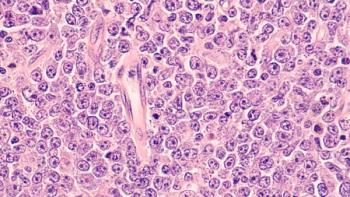
New ASCO Guideline Recommends Adjuvant Olaparib for Patients with Hereditary Breast Cancer
ASCO updated its guidelines following a presentation of the OlympiA trial presented at its 2021 Annual Meeting.
Updated American Society of Clinical Oncology (ASCO) guidelines advise offering patients with high-risk, early-stage human epidermal growth factor receptor 2 (HER2)-negative breast cancer and germline BRCA mutations 1 year of adjuvant therapy with olaparib (Lynparza) following completion of neoadjuvant chemotherapy and local treatment, including radiation.
The recommendation follows a new ASCO initiative intent on providing clinicians with updated and timely guidelines that represent the latest practice-changing research. ASCO, the American Society for Radiation Oncology (ASTRO), and the Society of Surgical Oncology (SSO) will be updating their guidelines in accordance with the new recommendation.
The newly updated recommendation reflects data provided by the randomized OlympiA trial, which was published in the New England Journal of Medicine and presented at the 2021 ASCO Annual Meeting.
The OlympiA trial found that patients with high-risk, HER2-negative early breast cancer and germline BRCA1 or BRCA2 pathogenic or likely pathogenic variants who had completed local treatment and neoadjuvant or adjuvant chemotherapy demonstrated significantly longer invasive and distant disease-free survival when receiving adjuvant olaparib compared with placebo.
The study did not indicate that olaparib had a meaningful effect on global patient-reported quality of life.
The pre-specified event interim analysis had a median follow-up of 2.5 years. In total, 1836 patients were randomized 1:1 to receive either oral olaparib or placebo. The primary end point was invasive disease-free survival.
At 3 years, invasive disease-free survival was 85.9% in the olaparib group and 77.1% in the placebo group, while distant disease-free survival rates were 87.5% and 80.4%, respectively.
In addition, the olaparib group reported fewer deaths than the placebo group (59 vs. 86, respectively).
“The OlympiA trial was designed to test the efficacy of adjuvant PARP inhibitor therapy with olaparib in patients with early breast cancer and impaired BRCA1 or BRCA2 homologous-recombination function, identified by the presence of a BRCA1 or BRCA2 germline pathogenic or likely pathogenic variant as a patient-selection biomarker,” said Andrew N.J Tutt, MB, ChB, PhD, and colleagues. “The trial shows that olaparib given for 52 weeks as adjuvant therapy after neoadjuvant or adjuvant chemotherapy and local therapy resulted in significantly longer survival free of invasive or distant disease than placebo in such patients.”
Following randomization, routine medical history reports and physical examinations occurred at predetermined intervals: 4 weeks for the first 24 weeks, every 3 months from 24 weeks through year 2, every 6 months between 3 and 5 years, and annually thereafter.
Mammography and breast magnetic resonance imaging measured the development of metastatic diseases. Following a first event, patients were monitored for first distant relapse (if not the first event), central nervous system metastases, locoregional relapses, contralateral breast cancer, second primary cancers, and survival status.
As defined at the time of randomization, primary end points consisted of the date of the first occurrence of the following events: ipsilateral invasive breast tumor, locoregional invasive disease, distant recurrence, contralateral invasive breast cancer, second primary invasive cancer, or death from any cause, in accordance with the standardized definitions for efficacy end points (STEEP) system.
Disease-free survival, overall survival, and safety all served as secondary end points.
Adverse events (AEs) were consistent with those previously reported. The olaparib group did not report more serious AEs than the placebo group and the majority of AEs associated with olaparib were grade 1 or 2. In regard to toxic effects over grade 3, 8.7% of patients reported anemia but no other serious AE was reported by more than 5% of patients. Although the anemia infrequently led to infusion, dose interruption and reductions proved to be effective management strategies.
The 2021 updated recommendation is as follows: For patients with early-stage, human epidermal growth factor receptor 2 (HER2)–negative breast cancer with high risk of recurrence and germline BRCA1 or BRCA2 pathogenic or likely pathogenic variants, 1 year of adjuvant olaparib should be offered after completion of neoadjuvant chemotherapy and local treatment, including radiation. For those who had surgery first, adjuvant olaparib is recommended for patients with [triple-negative breast cancer (TNBC)] and tumor size > 2 cm or any involved axillary nodes for patients with hormone receptor-positive disease, adjuvant olaparib is recommended for those with at least 4 involved axillary lymph nodes. For patients who had neoadjuvant chemotherapy, adjuvant olaparib is recommended for patients with TNBC and any residual cancer. Adjuvant olaparib is recommended for patients with residual disease and an estrogen receptor status and tumor grade (CSP+EG) score ≥3.
References
- ASCO News Release. ASCO releases rapid guideline recommendation update for certain patients with hereditary breast cancer. Published June 15, 2021.
https://www.asco.org/about-asco/press-center/news-releases/asco-releases-rapid-guideline-recommendation-update-certain . Accessed June 21, 2021. - Tutt ANJ, Garber JE, Kaufman B, et al. Adjuvant Olaparib for Patients with BRCA1- or BRCA2-Mutated Breast Cancer N Eng J Med. 2021; 384:2394-2405. doi:10.1056/NEJMoa2105215.


















































































